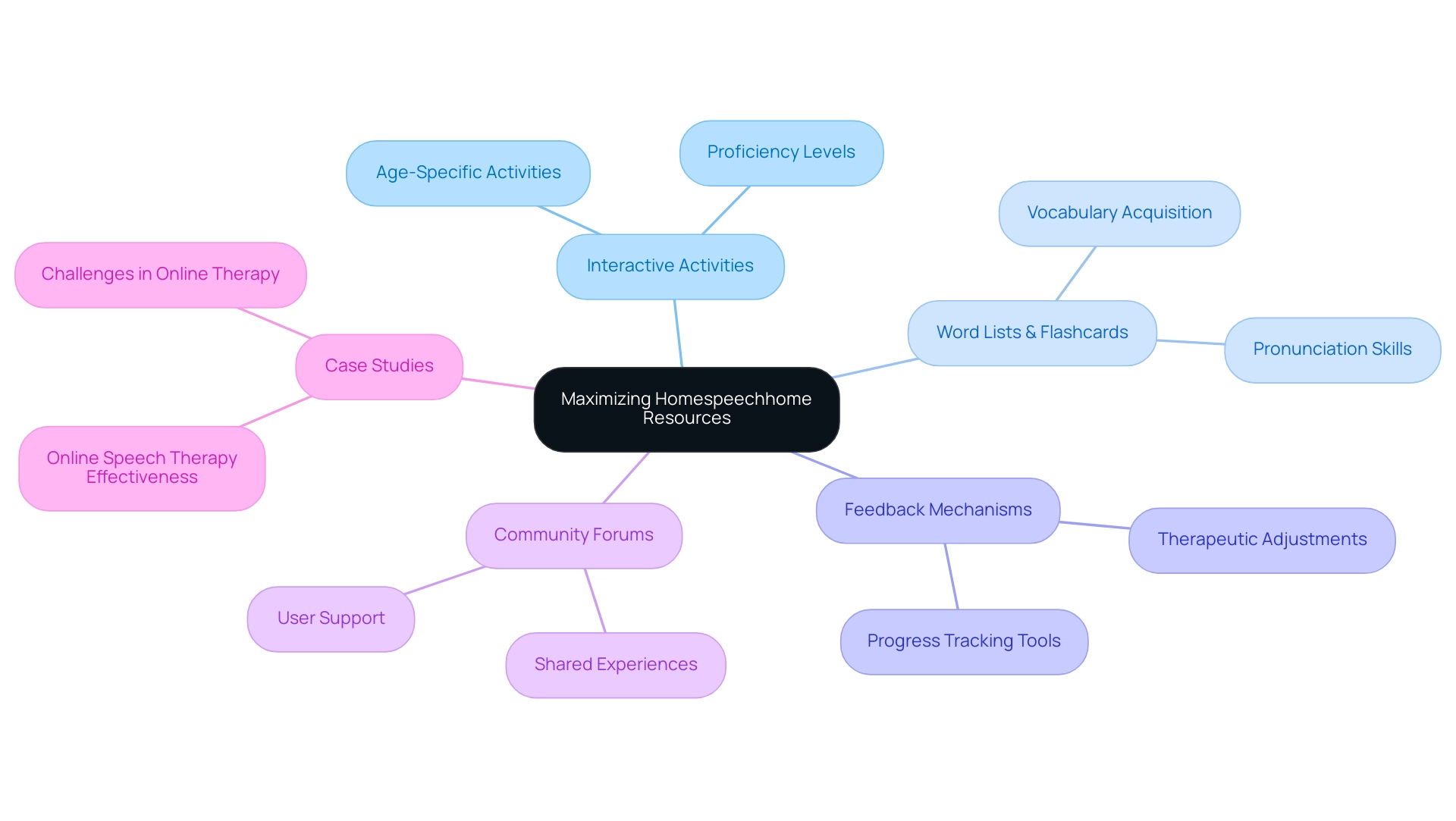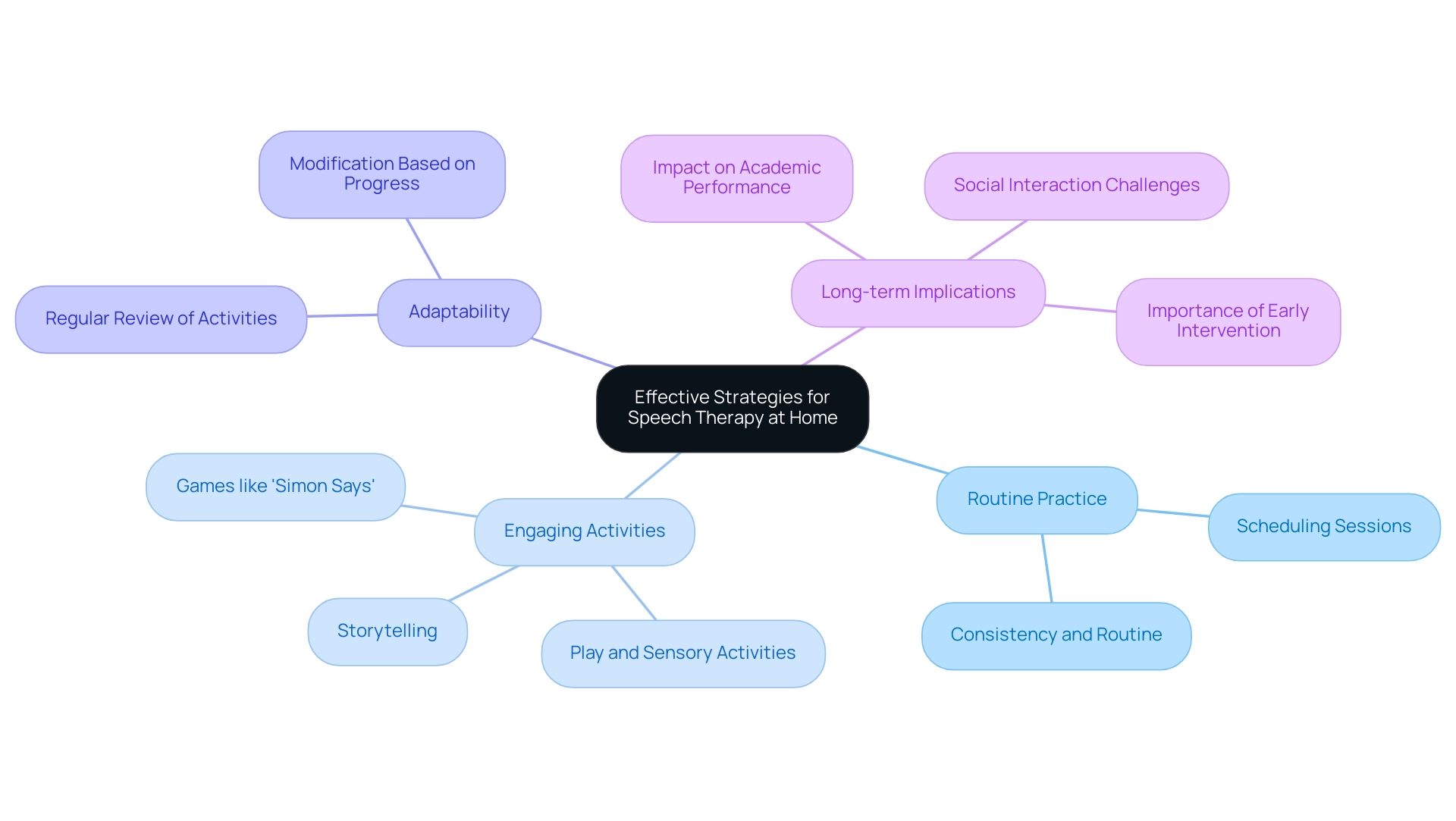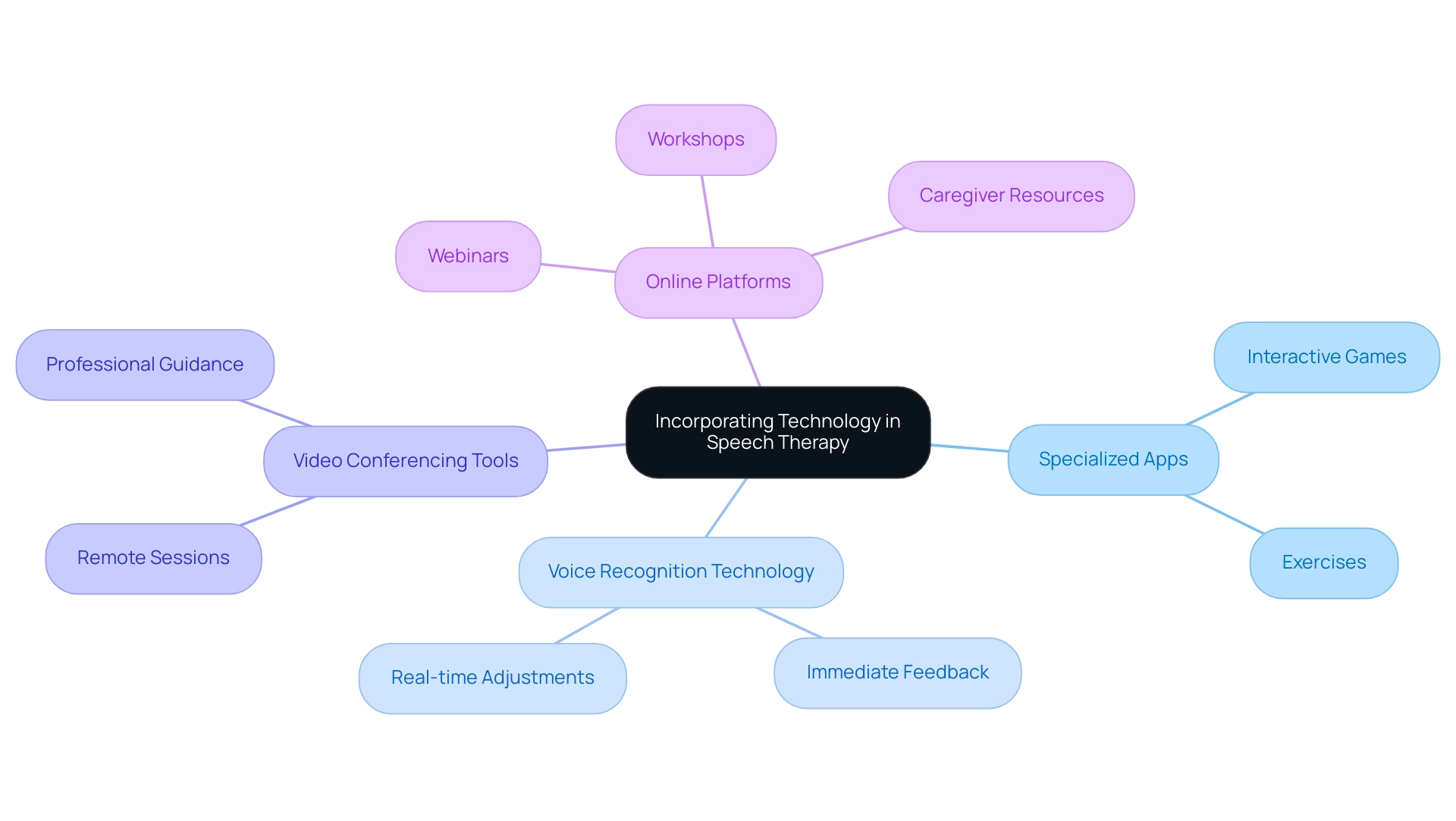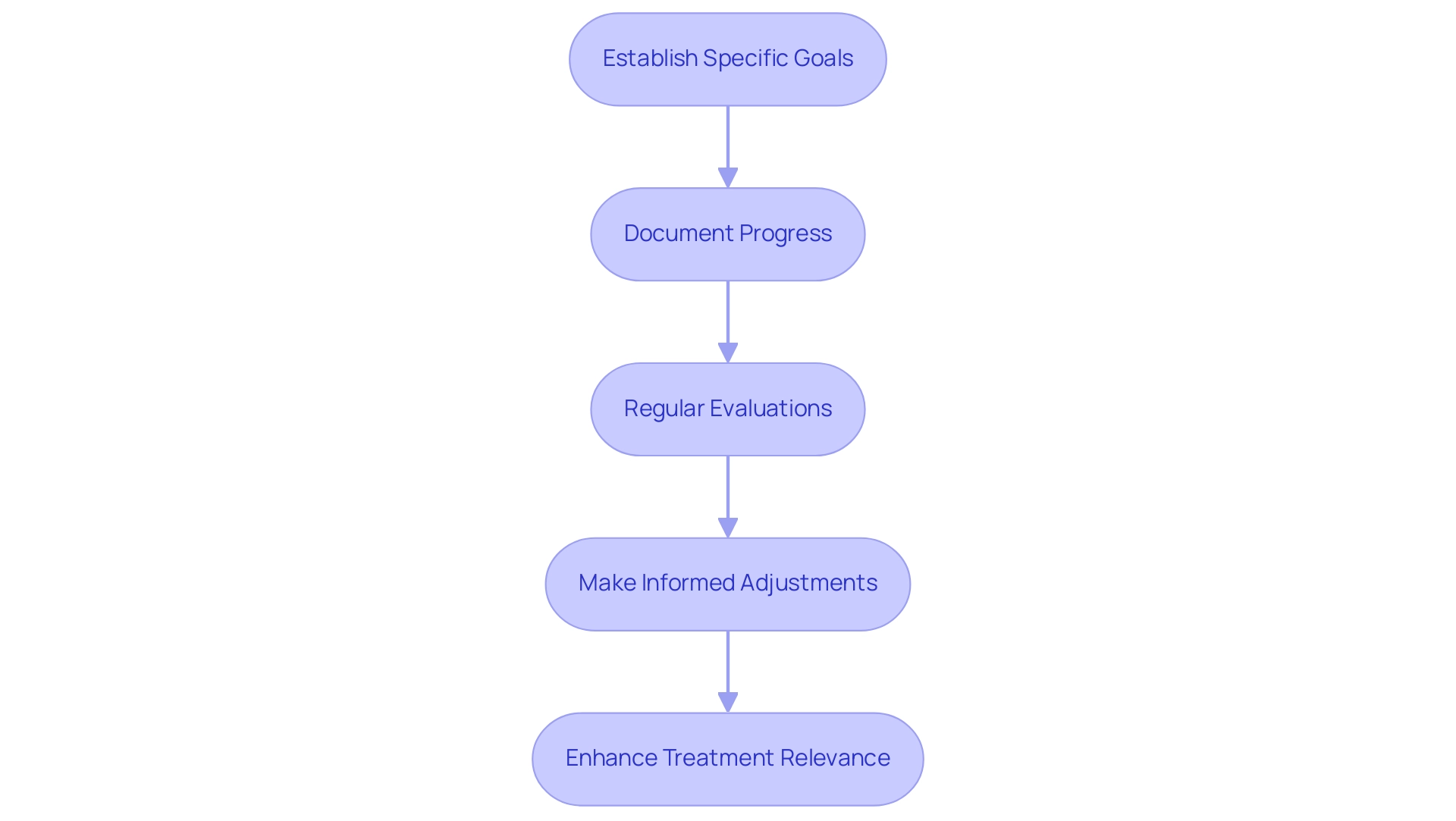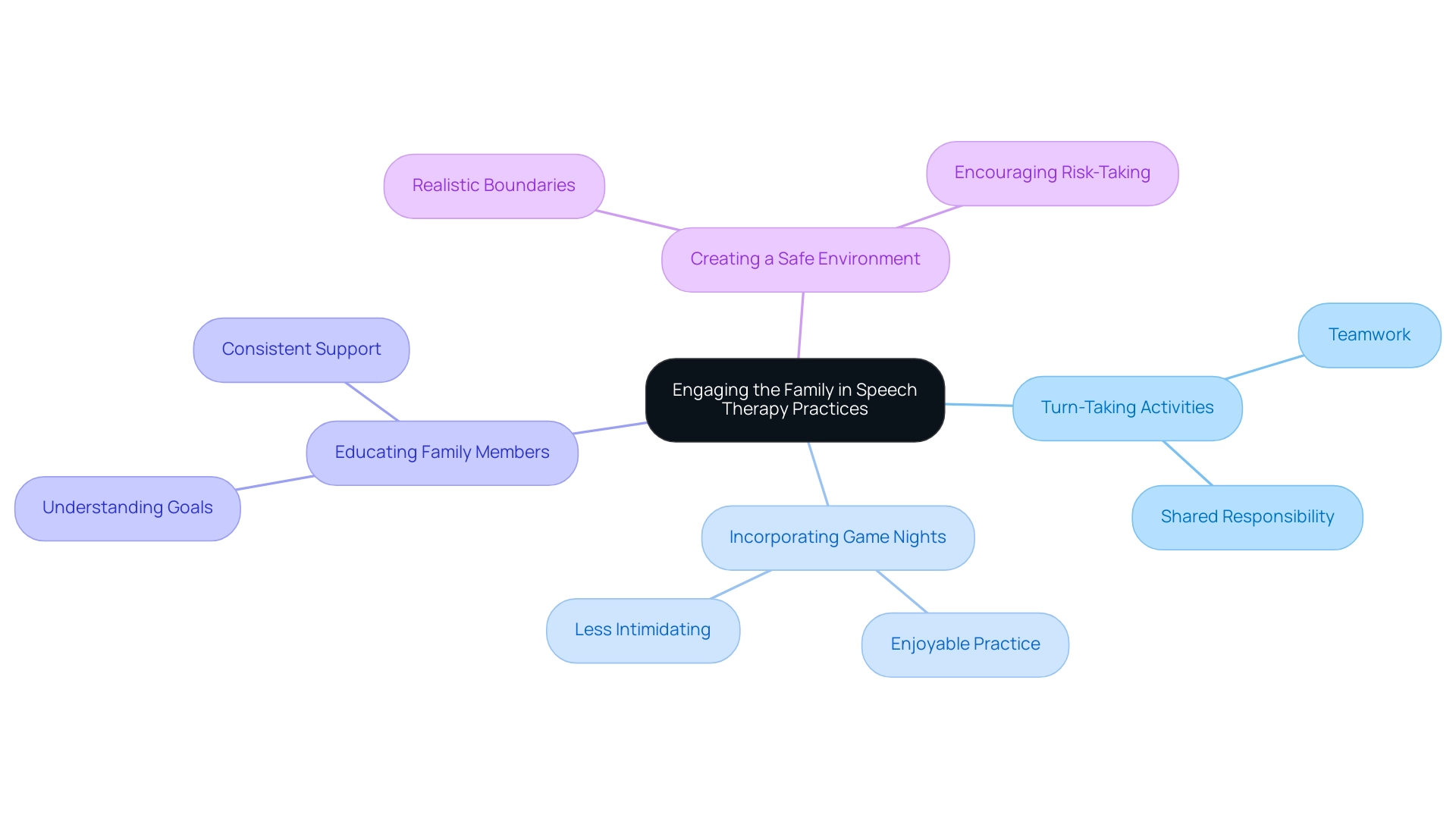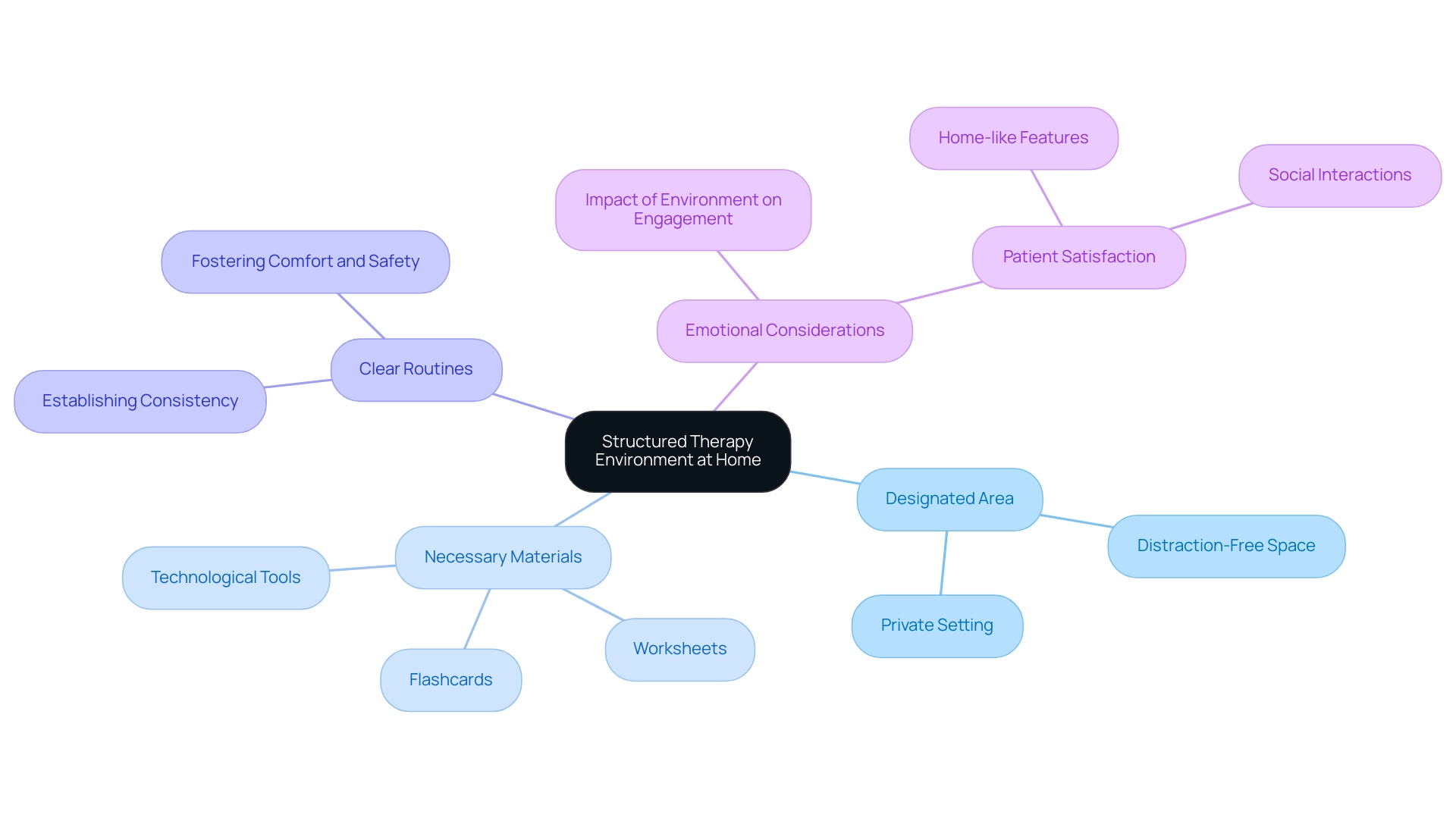Introduction
Creating an effective speech therapy environment at home involves a multifaceted approach that combines the right resources, strategies, and family engagement. As families navigate the complexities of speech development, understanding how to maximize available tools—such as those offered by HomeSpeechHome—becomes crucial.
Research has shown that online resources can significantly enhance children's speech outcomes, but the real challenge lies in implementing these tools effectively. From establishing structured routines to incorporating technology and engaging family members, every aspect plays a vital role in fostering an environment conducive to communication growth.
This article explores key strategies and insights for optimizing home speech therapy, ensuring that caregivers are equipped to support their loved ones on their journey to improved speech and language skills.
1. Maximizing the Use of HomeSpeechHome Resources in Speech Therapy
To fully utilize the benefits of homespeechhome resources in communication assistance, it is essential to become acquainted with the
wide range of tools available on the homespeechhome platform. A study assessing a database of 1114 evaluations with 1077 children emphasizes the effectiveness of online communication resources, demonstrating their value in aiding children's language development. Begin by exploring the interactive activities designed for different age groups and communication proficiency levels.
For example, utilizing word lists and flashcards can significantly enhance vocabulary acquisition and pronunciation skills. Regular access to the comprehensive online library of resources will facilitate the development of a structured treatment plan that meets the unique needs of each individual. Additionally, implementing feedback mechanisms—such as progress tracking tools—can effectively highlight areas requiring improvement, allowing for necessary adjustments to the therapeutic approach.
Engaging with community forums also offers valuable insights and support from fellow users, effectively enriching the experience for those navigating similar challenges. As one mother of two young boys shared, 'Join me on this parenting journey of learning and discovery,' emphasizing the shared experience of families utilizing these resources. Moreover, a case study on online communication assistance shows that although challenges are present, including technical difficulties, there has been a significant enhancement in family participation in therapeutic activities.
This multifaceted approach ensures that families are equipped to maximize the effectiveness of their homespeechhome communication improvement endeavors.
2. Effective Strategies and Activities for Speech Therapy at Home
Implementing effective strategies for homespeechhome intervention is crucial in facilitating significant progress, especially considering that more women than men are affected by spasmodic dysphonia. Establishing a regular schedule for practice sessions helps cultivate consistency and routine, which are essential for development. Incorporating engaging activities, such as storytelling, allows caregivers to prompt children to describe pictures or summarize narratives using designated word lists, promoting both language skills and comprehension.
As a speech-language pathologist points out, 'To tackle this challenge, speech-language pathologists (SLPs) who focus on working with young children integrate play and sensory activities into sessions. Additionally, games like 'Simon Says' can transform learning into an enjoyable experience while targeting articulation and listening skills. Statistics indicate that group therapy can be more cost-effective and time-efficient, enabling therapists to work with several people at once. For older adults, role-play scenarios can effectively encourage conversational skills and expand vocabulary.
It is vital to regularly review and modify these activities based on the individual's progress, as adaptability can lead to enhanced outcomes. The
long-term implications of communication and language disorders underscore the importance of early intervention; neglecting these disorders can lead to significant challenges in academic performance and social interactions. By combining structured practice with enjoyable activities, caregivers can cultivate a supportive homespeechhome environment that is crucial in promoting communication development.
3. Incorporating Technology for Enhanced Speech Therapy
The incorporation of
technology into homespeechhome treatment offers a dynamic and engaging approach to addressing speech challenges. Utilizing specialized apps that feature interactive games and exercises can significantly enhance the therapy experience. However, it is essential to note that 53.75% of speech-language pathologists (SLPs) indicated that the effectiveness of mHealth services is not equal to in-person consultations, highlighting the need for critical evaluation of these digital resources.
Programs equipped with voice recognition technology provide immediate feedback on pronunciation, enabling users to make real-time adjustments to their verbal communication. Furthermore, video conferencing tools facilitate remote sessions with licensed therapists, ensuring professional guidance when necessary. As Juliane Leinweber highlights, future education and training should concentrate on the functional aspects of these technologies to positively affect therapists' intention to utilize digital tools in treatment, ultimately encouraging patients' digital participation.
Online platforms hosting webinars and workshops also serve as valuable resources for caregivers, equipping them with effective strategies and educational materials. By utilizing such technologies, caregivers not only create a more engaging treatment atmosphere but also encourage regular practice and learning, ultimately improving the impact of homespeechhome communication assistance.
4. Tracking Progress and Setting Goals in Speech Therapy
Monitoring progress in verbal rehabilitation is essential in assessing the effectiveness of the techniques utilized. It begins with establishing specific, measurable goals tailored to the person's unique needs, such as enhancing the articulation of particular sounds or broadening vocabulary. Utilizing tools like those offered on homespeechhome facilitates the documentation of progress over time, allowing for a comprehensive overview of advancements and areas that may require further attention.
As emphasized by specialists, 'The cost of effective speech treatment is often assessed by the progress achieved.' Regular evaluations of these goals allow therapists and caregivers to make informed adjustments based on the person's development. Moreover, group sessions can be more economical and time-saving, enabling practitioners to engage with several people at once, which can improve the overall healing experience.
The case study regarding the SLP Toolkit illustrates the importance of
visual supports in tracking progress, despite concerns about data tracking and program costs. This organized method not only encourages motivation by recognizing small achievements but also guarantees that the treatment remains in tune with the individual’s changing needs. By diligently keeping a record of progress, caregivers can greatly enhance the relevance and efficacy of communication interventions.
5. Engaging the Family in Speech Therapy Practices
Involving family members in homespeechhome improvement activities is essential for
maximizing the effectiveness of home treatment. One effective strategy is to encourage family members to take turns leading activities, fostering a sense of teamwork and shared responsibility. Incorporating homespeechhome activities into family game nights can also make practice more enjoyable and less intimidating, seamlessly blending therapeutic exercises with everyday life.
It is equally important to educate family members about the specific goals and strategies used in treatment, ensuring they can offer consistent support and encouragement. This collaborative method not only strengthens the lessons acquired in counseling but also boosts the child's competence and self-worth in communication, which is the ultimate aim of oral communication. As highlighted in the case study titled 'Helping Children with Apraxia Become Risk-Takers with their Speech and Communication,' creating a safe and predictable environment—where boundaries are respected and expectations are realistic—can significantly encourage children to take risks in their communication.
By applying these approaches, families can play a crucial role in their child's advancement in verbal development, ultimately resulting in enhanced communication abilities. As noted by Apraxia-KIDS, 'If you can make this a habit, you can see remarkable results.
6. Creating a Structured Therapy Environment at Home
Creating a structured treatment environment in homespeechhome is crucial for maximizing the effectiveness of speech sessions. Designating a specific area for counseling sessions that is devoid of distractions—such as television and other loud noises—creates a conducive atmosphere for learning. This is particularly important as shared rooms have been associated with feelings of unsafety among female patients, emphasizing the need for a private space.
The treatment area should be well-equipped with necessary materials, including:
- Worksheets
- Flashcards
- Any relevant technological tools that can facilitate the process
It is beneficial to establish clear routines for treatment sessions, as this helps individuals understand what to expect and fosters a sense of comfort and safety. Consistency in the environment contributes significantly to a feeling of stability, which in turn allows for better focus on speech activities.
As one patient observed, 'The physio informed me that if it doesn’t improve, they will need to
perform surgery on me,' emphasizing the emotional weight of treatment settings. Research has consistently demonstrated that a distraction-free environment enhances engagement and effectiveness during sessions. Furthermore, a case study on the effects of a homespeechhome environment on patient satisfaction recommended incorporating such features to enhance social interactions and overall satisfaction.
By fostering an organized and supportive environment, caregivers can significantly improve the quality of speech therapy, leading to enhanced outcomes for individuals undergoing treatment.
Conclusion
Maximizing the potential of home speech therapy requires a comprehensive approach that encompasses various strategies, resources, and family involvement. By leveraging tools available through platforms like HomeSpeechHome, caregivers can tailor activities to meet the unique needs of each individual, fostering an environment conducive to speech development. Engaging with interactive resources, incorporating technology, and establishing structured routines are all essential components that enhance the effectiveness of therapy sessions.
Family engagement plays a pivotal role in the success of home speech therapy. Encouraging family members to participate actively in therapy activities not only strengthens support systems but also makes the learning process more enjoyable. By creating a collaborative atmosphere, caregivers can help children feel more confident in their communication skills, ultimately leading to better outcomes.
Tracking progress and setting measurable goals are critical to understanding the effectiveness of therapy techniques. Regular assessments enable caregivers to make informed adjustments and celebrate small victories, reinforcing motivation for continued progress. A structured therapy environment, free from distractions, further enhances focus and engagement, allowing individuals to thrive in their communication journey.
In conclusion, a multifaceted approach that combines the right resources, effective strategies, and active family participation is key to optimizing speech therapy at home. By fostering a supportive and structured environment, caregivers can significantly contribute to their loved ones' speech and language development, ensuring a brighter future for effective communication.
